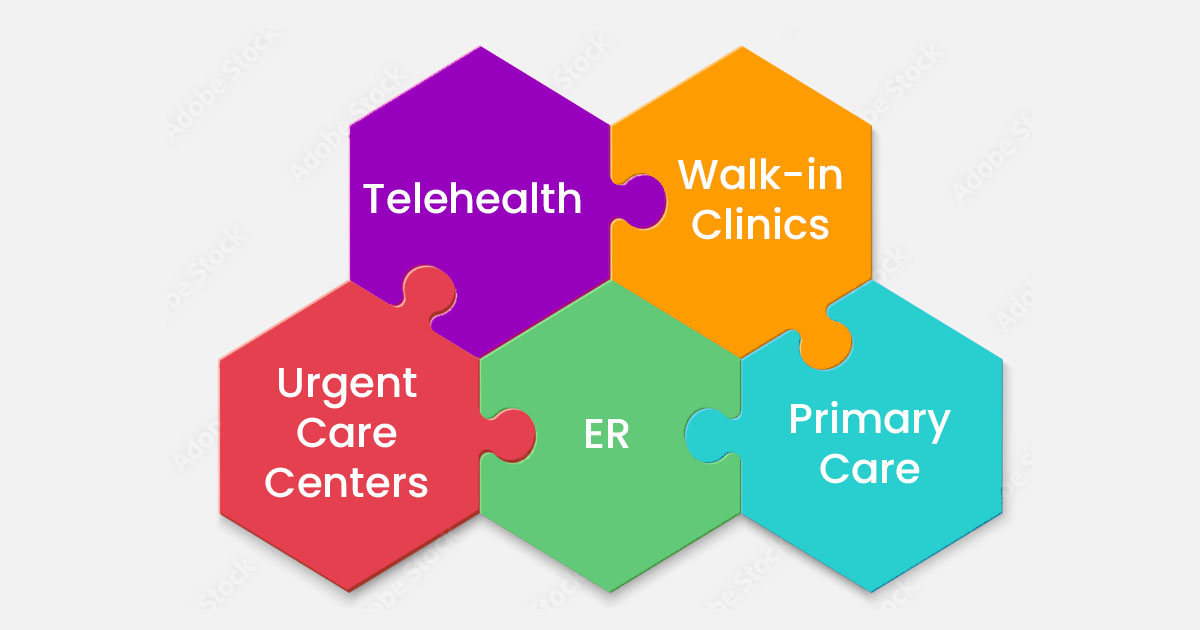
When it comes to managing our health, having access to the right healthcare benefits is crucial. From routine check-ups to unexpected emergencies, understanding the various types of healthcare services available can help us make informed decisions. In this comprehensive guide, we will explore and demystify different healthcare benefits, including telehealth, walk-in clinics, urgent care centers, primary care, and emergency rooms. Let’s dive in!
Telehealth has revolutionized the way healthcare is delivered, providing convenient access to medical professionals through digital platforms. With telehealth, individuals can connect with doctors, specialists, or therapists remotely using video calls or phone consultations. This type of healthcare benefit offers numerous advantages, such as:
Accessibility: Overcoming geographical barriers and ensuring care for individuals in remote or underserved areas.
Convenience: Eliminating the need for travel and allowing for flexible scheduling.
Time and Cost Savings: Reducing transportation expenses and minimizing time spent in waiting rooms.
Follow-up Care: Enabling regular check-ins and ongoing monitoring of chronic conditions.
Walk-in clinics are non-emergency medical facilities that provide immediate care for minor illnesses and injuries. These clinics typically operate on a first-come, first-served basis, without requiring appointments. Key features of walk-in clinics include:
Quick Access: Patients can seek medical attention promptly without prior appointments.
Extended Hours: Many walk-in clinics offer extended operating hours, making them convenient for those with busy schedules.
Minor Health Concerns: Walk-in clinics are well-suited for non-life-threatening conditions like flu, colds, minor cuts, sprains, and vaccinations.
Cost-Effective: Compared to emergency rooms, walk-in clinics often offer more affordable care options.
Urgent care centers bridge the gap between primary care and emergency room services. These facilities cater to immediate but non-life-threatening medical needs that require prompt attention outside of regular office hours. The key features of urgent care centers are:
Timely Care: Urgent care centers provide medical services promptly, usually within a few hours.
Variety of Services: They handle a wide range of conditions, from minor injuries and infections to diagnostic tests and X-rays.
Convenience: With extended hours and walk-in availability, urgent care centers are suitable for unexpected healthcare needs that cannot wait for a primary care appointment.
Cost-Efficiency: While more expensive than primary care, urgent care centers tend to be more affordable than emergency room visits.
Primary care serves as the foundation of healthcare, emphasizing preventive care, managing chronic conditions, and addressing routine medical needs. Here are some key aspects of primary care:
Long-Term Relationships: Primary care providers develop an ongoing relationship with patients, understanding their medical history and providing personalized care.
Preventive Care: Regular check-ups, vaccinations, screenings, and health education are vital components of primary care.
Management of Chronic Conditions: Primary care providers help individuals manage chronic diseases like diabetes, hypertension, and asthma.
Referrals and Coordination: Primary care providers coordinate specialist referrals and serve as the central point of contact for comprehensive healthcare.
Emergency rooms are designed to handle severe and life-threatening medical conditions requiring immediate attention. Some important features of emergency room care include:
24/7 Availability: Emergency rooms operate around the clock, ready to respond to critical medical emergencies.
Advanced Care: ERs are equipped with specialized medical equipment and staffed by a multidisciplinary team to handle emergencies.
Trauma Care: ERs are prepared to treat severe injuries, major illnesses, and critical accidents.
Higher Costs: Due to their advanced resources and round-the-clock operation, emergency room visits tend to be the most expensive option.
Understanding the different types of healthcare benefits available is essential for making informed decisions about our well-being. Telehealth, walk-in clinics, urgent care centers, primary care, and emergency rooms each serve specific purposes and cater to different medical needs. By utilizing these resources appropriately, we can access the right level of care, improve health outcomes, and optimize our healthcare experiences. Remember to consult your healthcare provider or insurance provider for specific details about your coverage and access to these benefits. Prioritize your health, be proactive, and make the most of the healthcare options available to you.
Disclaimer: This article is for informational purposes only and should not be considered medical advice. Please consult with a qualified healthcare professional for personalized guidance on your specific healthcare needs.
